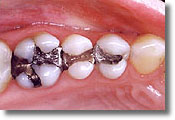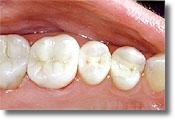If you were in need of fillings to repair cavities, which of the options below would you prefer?

Amalgam Fillings

Same Teeth with White Fillings
In this case, pictures speak a thousand words. If given the choice, the overwhelming majority of people will choose white fillings over amalgams, if only for aesthetic reasons. However, white fillings offer several additional advantages over amalgam.
Advantages of White Fillings
- White fillings look like part of your natural tooth.
- White fillings bond to your tooth, unlike amalgam fillings, and actually restore more of the strength of your natural tooth. The silver in amalgam fillings actually weakens your tooth, making it more vulnerable to cracking or breaking.
- The composite material in white fillings does not conduct heat or cold like the amalgam material does, making teeth restored with white fillings less sensitive when done appropriately.
- The composite material in white fillings does not contain mercury, a known toxin.
- Proper application of an amalgam filling requires that a greater part of the tooth is drilled away (see picture on left below). A white filling requires removal of only the decay, yielding a much smaller change to the natural tooth structure (see picture on right).

Prep for an Amalgam Filling

Prep for White Filling
Amalgam fillings have also been the center of an ongoing controversy in the dentistry world. The material in amalgam fillings is nearly 50% mercury, a known neuro-toxin. Most general dentists refer to amalgam fillings as “silver fillings”, even though they have more mercury than silver in them, because people know mercury is toxic. Current research regarding the safety of mercury fillings remains inconclusive—a small amount of mercury vapor does appear to be released during chewing, but it has not yet been determined whether that small amount of vapor is harmful to the body.
Click here to read more about Dr. Patel’s stance as a mercury-free dentist.
Advantages of Amalgam Fillings
Although Dr. Patel does not place amalgam fillings, some dentists still use them due to a few limited advantages.
- They are generally less expensive, and take less time to place than white fillings.
- General dentists can place them without any extra training.
- The filling material itself is stronger than composite material, though it weakens the remaining tooth structure.
Why Choosing the Right Dentist is So Important
In the past, general dentists were not required to learn how to place white composite fillings as part of their general dentistry training. As a result, many do not offer or encourage this service.
If you request white fillings, and your dentist seems uncomfortable or uncertain, do not press the issue. Seek the services of a dentist who has been trained in the placement of white composite fillings. If you insist on a treatment option your dentist is not experienced in performing, the results may very well be substandard.
White Fillings and Alcohol Consumption
A word of caution—if you consume beverages with a high alcohol content on a daily basis, white fillings may not be your best option. Beverages that have a high alcohol content (i.e., hard liquors) make the composite material used in white fillings deteriorate more quickly.


